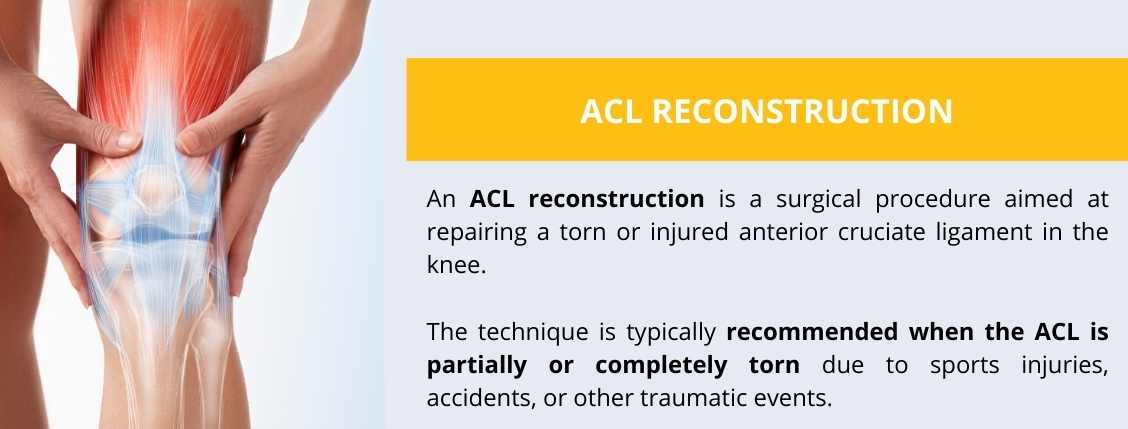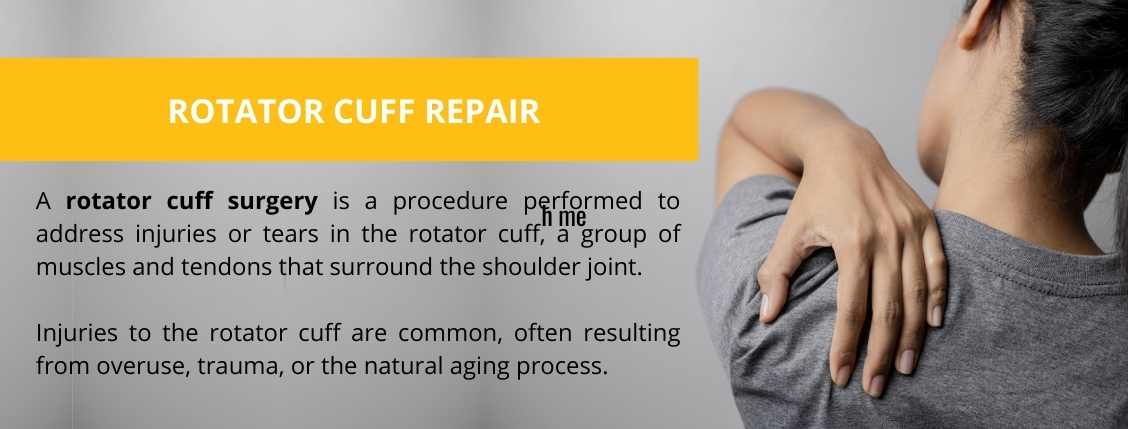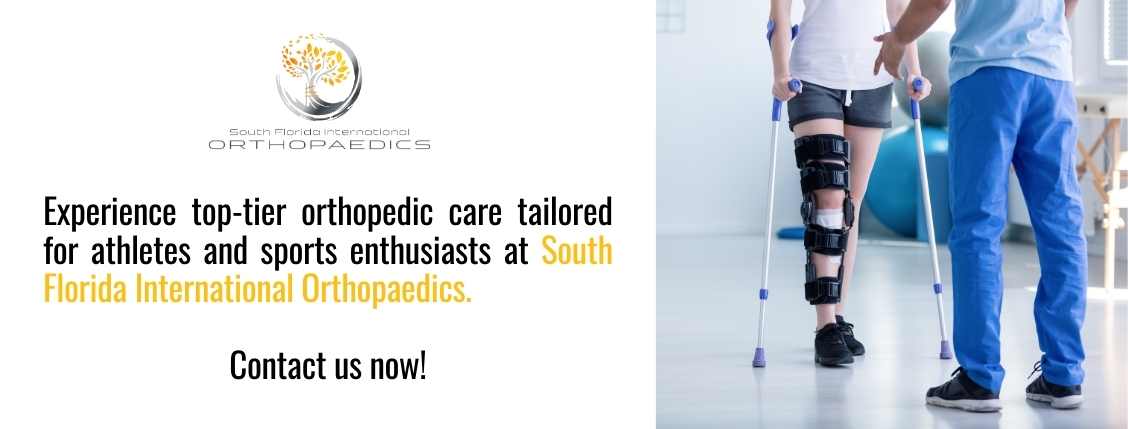In the high-stakes arena of sports, athletes often face the challenges of injuries that demand precise medical interventions. Orthopedic sports surgeries play a pivotal role in restoring functionality and allowing athletes to reclaim their positions on the field.
Let’s delve into the realm of these surgeries, exploring their prevalence, procedures, and the path to recovery.
What are the most common orthopedic sports surgeries?
Sports enthusiasts and athletes alike are no strangers to the term “orthopedic sports surgeries.” But what exactly do these procedures entail? Some of the most common orthopedic sports surgeries include the following:
1. ACL reconstruction
An ACL reconstruction is a surgical procedure aimed at repairing a torn or injured anterior cruciate ligament in the knee.

The technique is typically recommended when the ACL is partially or completely torn due to sports injuries, accidents, or other traumatic events.
Common situations leading to ACL injuries include sudden stops or changes in direction, direct impact to the knee, or awkward landings after jumps. Here’s an overview of the ACL reconstruction process:
- Arthroscopy: In most cases, ACL reconstruction is performed using arthroscopy, a minimally invasive technique. Small incisions are made, and a tiny camera (arthroscope) is inserted to visualize the interior of the knee joint.
- Graft placement: The selected graft is then secured in place of the damaged ACL. The surgeon uses screws or other fixation devices to anchor the graft in the femur and tibia, mimicking the natural position and function of the original ligament.
- Closure: After securing the graft, the surgeon closes the incisions, and the knee is typically bandaged.
ACL reconstruction is a common procedure among athletes who wish to return to high-impact sports, as a reconstructed ACL provides stability and reduces the risk of further knee injuries.
2. Meniscus tear repair
A meniscus tear repair is a surgical procedure to treat a torn meniscus in the knee. The meniscus is a wedge-shaped cartilage in the knee joint that acts as a cushion and provides stability.
Meniscus tears are common injuries, often occurring during activities that involve twisting or sudden stops, such as pivoting in sports or heavy lifting. Here’s an overview of the meniscus tear repair process:
- Arthroscopy: Orthopedic specialists typically perform meniscus tear repair arthroscopically, a minimally invasive technique.
- Trimming or repair: Depending on the type, size, and location of the meniscus tear, the surgeon may choose to trim the damaged part of the meniscus (partial meniscectomy) or repair it.
Repair is typically preferred for tears in the outer, more vascularized region of the meniscus, where blood supply facilitates healing.
- Suturing the tear: If a repair is deemed suitable, the torn edges of the meniscus are brought together, and sutures or other fixation devices are used to secure and stabilize the tear. This promotes the natural healing of the meniscus tissue.
3. Rotator cuff repair
A rotator cuff surgery is a procedure performed to address injuries or tears in the rotator cuff, a group of muscles and tendons that surround the shoulder joint.

Injuries to the rotator cuff are common, often resulting from overuse, trauma, or the natural aging process. Here is an overview of the rotator cuff repair process:
- Arthroscopy: Rotator cuff repair is often performed arthroscopically.
- Tendon preparation: If the tear is amenable to repair, the surgeon may prepare the torn tendon ends by removing damaged tissue and creating a clean surface for healing.
- Suture anchors: Small devices with attached sutures (called suture anchors) are then used to reattach the torn tendon to the bone. These anchors are strategically placed to secure the tendon in its proper position.
- Closure: After the repair is completed, the incisions are closed, and the shoulder is typically bandaged.
4. Shoulder labrum repair
The shoulder labrum is a ring of cartilage that surrounds the socket of the shoulder joint, providing stability and support to the shoulder. Injuries to the labrum are common, often resulting from traumatic events, repetitive shoulder motions, or dislocations.
A shoulder labrum repair is used to address injuries or tears in the shoulder’s labrum. Here’s how the procedure typically goes:
- Arthroscopy: Similar to other orthopedic surgeries, shoulder labrum repair is often performed arthroscopically.
- Debridement and preparation: If the labrum tear is repairable, the surgeon may debride or trim any damaged tissue and prepare the torn edges for repair.
- Anchor placement: Suture anchors, small devices with attached sutures, are used to reattach the labrum to the bone. These anchors are strategically placed in the bone to secure the labrum properly.
This surgical intervention is often recommended for individuals with persistent shoulder pain, recurrent dislocations, or other symptoms associated with labral tears that do not respond to conservative treatments.
5. Achilles tendon repair
Achilles tendon repair is a surgical procedure to treat a torn or ruptured Achilles tendon, which is the large tendon connecting the calf muscles to the heel bone.
The Achilles tendon is crucial for activities such as walking, running, and jumping, and injuries to this tendon can significantly impact mobility. Here’s an overview of how the repair process plays out:
- Tendon realignment: If the tear is partial, the surgeon may realign the torn ends and suture them together. For a complete rupture, the surgeon may use various techniques to approximate the two ends of the tendon.
- Reinforcement: In some cases, the surgeon may reinforce the repair with other tissues or grafts to enhance the strength and stability of the repaired Achilles tendon.
- Immobilization: Following surgery, the patient is often placed in a cast or a walking boot to immobilize the ankle and protect the repaired tendon during the initial stages of healing.
6. Tennis elbow surgery
Tennis elbow surgery, also known as lateral epicondylitis surgery, is a procedure designed to treat severe cases of tennis elbow—a condition characterized by inflammation and degeneration of the tendons on the outer part of the elbow.
Despite its name, tennis elbow is not exclusive to tennis players; it can affect individuals engaged in repetitive arm movements. Here is an overview of tennis elbow surgery:
- Incision: The surgeon makes a small incision over the lateral epicondyle, the bony bump on the outer part of the elbow. This exposes the damaged tendon.
- Tendon debridement: The damaged or degenerated portions of the extensor tendon are removed or debrided to encourage healthy tissue regeneration.
- Tendon repair: In some cases, the surgeon may perform a tendon repair if there is a significant tear. This involves suturing the torn edges of the tendon to promote healing.
- Recovery: Following the procedure, the incision is closed, and the arm may be immobilized in a splint or brace.
7. Hip arthroscopy
Hip arthroscopy is a minimally invasive surgical procedure that allows surgeons to visualize, diagnose, and treat various hip conditions through small incisions using an arthroscope. Hip arthroscopy is commonly used to diagnose and treat multiple sports-related injuries and conditions, such as:
- Hip impingement
- Labral tears
- Hip dysplasia
- Synovitis
- Hip cartilage injuries
- Loose bodies in the joints
- Hip bursitis
The procedure usually starts with a small incision, usually less than 1 centimeter each, around the hip joint. These serve as entry points for the arthroscope and surgical instruments.
Once inside, the surgeon can explore the joint, identify specific problems, and assess the extent of any damage. They can perform labral repair, debridement, osteoplasty, loose body removal, and other techniques.
Hip arthroscopy offers advantages such as smaller incisions, reduced tissue damage, and potentially faster recovery compared to traditional open hip surgeries.
Where to find the best shoulder specialist in Miami?
Are you ready to experience top-tier orthopedic care tailored for athletes and sports enthusiasts?

South Florida Orthopedics leverages state-of-the-art diagnostic tools, including advanced imaging and arthroscopic technology. This ensures accurate and comprehensive assessments, leading to precise treatment plans for a swift and effective recovery.
Elevate your athletic performance, regain mobility, and rediscover the joy of movement with our expert Miami sports medicine team by your side. Contact us now or request an appointment.
The material contained on this site is for informational purposes only and DOES NOT CONSTITUTE THE PROVIDING OF MEDICAL ADVICE, and is not intended to be a substitute for independent professional medical judgment, advice, diagnosis, or treatment. Always seek the advice of your physician or other qualified healthcare providers with any questions or concerns you may have regarding your health.
